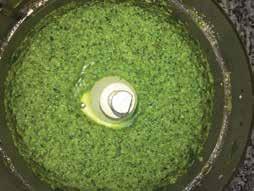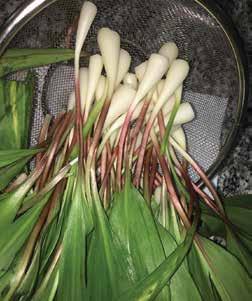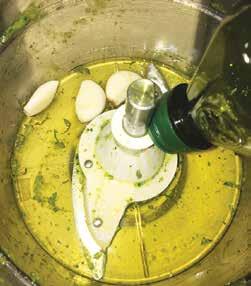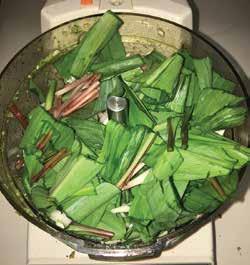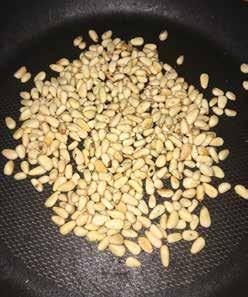
5 minute read
Lackawaxen Outdoors
Spring Foraging
Spring will soon be in the air in Lackawaxen Township, and residents are looking forward to sunshine and warmer temperatures after a long, trying winter. Trout season will kick off the outdoor enthusiasts list of hot topics, with the spring turkey hunting season coming in closely behind. With the warmer weather come so many outdoor opportunities, that it is sometimes difficult to decide what direction to go on any given day! These are all great pursuits, and all will provide sound exercise and quality time in the outdoors. They will also serve up some of the tastiest basics for delicious game dinners. Whatever you land or tag for the table at this time of year, one thing is for sure; Mother Nature has also provided the side dishes to perfectly compliment your entrée choice. Spring is the perfect time for some foraging for wild edibles among the hills of Pike County.
First up on the list is a weed that some people pay money to attempt to eradicate from their yards and gardens. Oddly enough however, the dandelion’s true name is Taraxacum Officinale, which means “the official remedy for disorders.”
Legend has it that the people of Atlantis used the dandelion as a food and a tonic. The early colonists brought the dandelion to America from Europe. They used all parts of the plant, even the roots, which they roasted and ground for a coffee-like drink. The frontier healers often recommended dandelion greens as a spring tonic. They are full of vitamins that were unavailable to pioneers during the winter. There is no doubt that dandelions have saved lives. The common name for this weed comes from the French Dent de Lion, meaning “lion’s tooth.” This refers to the jagged points on the leaves, which look like sharp teeth. The French grow dandelions to eat, just as we grow lettuce in our gardens. You can also purchase the lush greens in most any local supermarket, but if your yard is like mine, why not just gather a bunch for free.
Dandelion greens are best when picked young. The giant leaves get tough and bitter. Simply wash and drain and mix with the rest of your usual salad fixings. You can eat these greens raw or if you prefer, cook them for a few minutes in boiling water, drain and serve with butter on top. Better yet is to make a wilted salad with hot bacon dressing. How good are they for you? Consider that a “serving” is considered one cup, raw. Statistics show that dandelion greens are low in Saturated Fat (0%), and very low in Cholesterol (0%). They are also a good source of Folate (4%), Magnesium (5%), Phosphorus (4%) and Copper (5%), and a very good source of Dietary Fiber (8%), Vitamin A (112%), Vitamin C (32%), Vitamin E (9%), Vitamin K (535%), Thiamin (7%), Riboflavin (8%), Vitamin B6 (7%), Calcium (10%), Iron (9%), Potassium (6%) and Manganese (9%).
Next up at this time would be what some people refer to as “ramps” or wild leeks. Like the leeks you might buy in a store, the wild variety are much smaller and have a unique flavor. Ramps grow in moist but well-drained soils and stand out with their flat leaves of bright green color. The entire plant is edible from the roots up — almost like a scallion. To prepare them, just chop off the very end of the root system and wash them well to remove all the soil. Some people separate the whit bulb from the leaves and serve them separately. The leaves themselves have a great garlicky flavor which accentuates any garden salad. The entire ramp and can be sautéed or grilled to smoky perfection. The tops can also be sauteed like spinach and served with butter on top. All parts can be served raw, and I like to use the leaves and bulbs when chopped to make a super cream of leek soup. Ramps are a member of the onion family, the alliums, but they taste like some of the most pleasant garlic and onion flavor you could ever have. The maroon and the white parts are more for cooking. You toss them with scrambled eggs or home fries and bacon. An absolute favorite way for me to prepare and store my ramps, is to turn them into pesto, using toasted pine nuts or walnuts, garlic, olive oil and Parmesan cheese, and then putting the pesto into flat, vacuum sealed bags for freezing. If you have a dehydrator, you can also dry the entire ramp and then turn it to powder with a food processor and put it in a shaker to add flavor to any dish or salad!
As with any wild foraging, caution is always advised. If you are not sure what you are picking, get help from an expert. Wild leeks or ramps have a dangerous “look-a-like”, the Lily of the Valley. Lily of the valley is toxic to humans and should not be consumed. The way to tell is to crush a leaf in your fingers and smell it. Leeks have a strong onion smell, and the lily does not.
We can finish off today with what is in my opinion the most delicious wild edibles of all, but without a doubt the hardest to come by. Morel mushrooms make their appearance at this time of year when they want and where they want. They are not as common in our region as they are in the western part of the state. It will take a lot of doing on your own to locate an area, and once you do you will not be likely to give up that location. You will also then understand why you could never get anyone to tell you where and if they have found any! Morels mushrooms have a distinct cone like appearance with their surface looking somewhat brain like. These mushrooms prefer to grow in proximity to elm trees and old apple orchards along with recently burned areas. Morels sell for serious dollars in the grocery store because they do not cultivate well. Sautéed in butter, there are few foods that will rival the morel in delicate, earthy mushroom flavor. All these wild edibles are available now to sit beside whatever game or fish dinner gracing your table.
